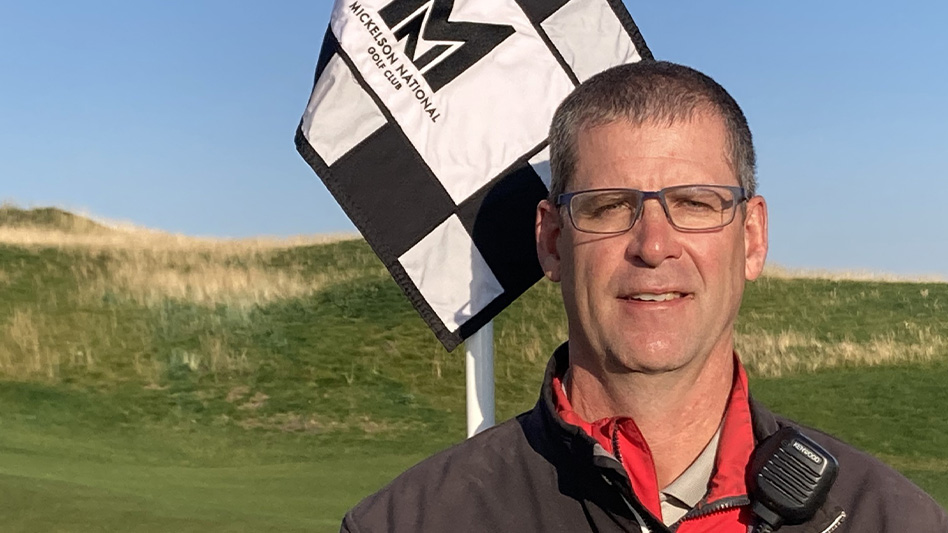
Courtesy of Mickelson National Golf Club (5)
Golf course superintendent Robin Sadler is digitally flipping through his Sustainability Scorecard and Carbon Footprint Report from GEO Sustainable Golf Foundation. We’re on the phone together, and he’s moving rather slowly, just feeling his way, because the PDF document had arrived only the day before. He stops on the section that quantifies the carbon footprint for his facility, Mickelson National Golf Club in Harmony, Alberta, Canada.
“So, for example, fuel as a percentage of our overall emissions. We know that switching from 72 gas-powered carts to 72 lithium battery carts saved us 18,000 liters of fuel: That’s 24,000 Canadian dollars in one year,” Sadler says. “That’s a real number and it’s what we expected — but to see it documented in the context of our footprint is another thing. I’m pretty floored by the feedback from GEO. The process takes all the information we provided relating to maintaining this facility — from the course itself to the clubhouse and kitchen. Every department at the club. So, what we’ll be able to do this winter is analyze all this data, determine what it says and how we will respond. Where we can be better?
“At the same time, I think superintendents recognize that working in the golf business today is a challenge — financially. And what we’re doing here, being GEO Certified is clearly going to be a financial win for the club.”
Sadler is one of 14 practicing Master Superintendents in Canada and past president of the Alberta Golf Superintendents Association. He arrived in Harmony four years ago, when Mickelson National was just winding up construction. A veteran of the Audubon program at his previous posting, the nearby Silvertip Resort, Sadler was eager for Mickelson National to pursue GEO accreditation. Twelve months later, it’s the first GEO Certified Facility in Canada.
And now the real work begins.
“This program is not a song or a dance,” he says. “We are seriously into doing our part: to be responsible, to use best practices, to reduce our carbon footprint, to innovate and set examples others can follow. I mean, we follow those examples ourselves. The GEO website is an amazing resource of what’s happening in sustainability around the world. The program checks a couple more boxes for us than Audubon in that respect. It focuses on a few different sustainability areas. I love the fact that it’s so global, that there is so much support and feedback from GEO.
“I thought, Let’s give this a try. And I have to say, I really, really like the program and process.”

GEO Sustainable Golf Foundation is an international not-for-profit based in North Berwick, Scotland. The programs it provides for golf are today being used in more than 75 countries. Founded more than 18 years ago as a pioneer in what has become the sport and sustainability movement, GEO is dedicated to helping golf navigate sustainability — across both the amateur and professional game — by providing strategy, industry-wide solutions and a credible certification label. The Foundation is dedicated to what it calls “a comprehensive, innovative approach to sustainability, via tailored platforms available to golf courses and facilities,” and it also partners with national and regional golf associations, tours and tournament competitions, and even professional players as individuals.
The sustainable golf community is large and diverse, yet it’s hard to imagine anyone making more use of GEO’s sustainability programs than superintendents like Sadler, who also sits on the Canadian Golf Superintendents Association Accreditation Committee. Superintendents understand better than anyone in golf that best maintenance practices and meaningful sustainability programs never stop. In fact, they look rather skeptically on certifications that don’t come with ongoing expectations attached.
“That’s the biggest thing, the long-term approach, which extends to every department at our club,” Sadler says. “How can we be better? Part of that is the footprint, carbon usage. It extends to everything we do as superintendents, which always ties back into the financial responsibility of the club.
“We hold up our end on the golf course side. But I know that, in the kitchen, they got a new meat cutter this spring where they’re able to shave scraps further and retool that for soups, creating less food waste. By participating in Operation Pollinator and collaborating with Harmony Honey, off site, the club supports pollinator habitats and harvests honey on site.”
It’s free to be part of the Sustainable Golf movement: Course facilities are encouraged to sign up and populate key facility data as part of what GEO calls the OnCourse program, which sits at the heart the sustainable golf system. Sadler pointed me to the Mickelson National “Highlights” page on the GEO website, where examples of his team’s innovation and sustainable practices are there for other community members to read and share, mimic or adapt. Using the website and participating in this global, online community comes at no charge.
“How you tie in from there is up to you,” Sadler says. “You can choose to be GEO Certified or just be part of the community at no cost. Here in Alberta, that’s meaningful because there is a great variety of golf clubs with varying financial options. There are big resorts and private clubs, too. It works for everyone.”
But Sadler feels that working toward sustainable practices in a concerted manner, facility-wide, has engendered huge, positive progression at Mickelson National GC: “We’re all part of a team effort here, more than anywhere I’ve ever been,” he says, “and a lot of it I credit to the GEO program.”

•••
Mickelson National is no small operation. It’s not exactly a resort either. It’s a brand-new planned community where the golf course, the residential, all the commerce and civic life have been built from scratch, just west of Calgary. Four years ago, when Sadler arrived from Silver Tip — where, in 2008, he and the team won a GCSAA/Golf Digest Environmental Leaders in Golf Award — there were 200 homes. Today there are 600 on the way to 4,200. The first lake and beach club are complete, no motorized water sport allowed. Ditto for another larger lake now under construction. There are shops opening downtown alongside medical clinics, sports fields and schools.
“We have a brand-new town here and it’s a pretty unique place,” Sadler says. “It’s also a unique opportunity to be part of it. That’s what drew me here four years ago. We have a goal of expanding this sustainability from the golf course operations into this community. In this day and age, golf clubs do have to be environmentally responsible.
“But the example we try to set also reminds us to share the stories of all the good things we do every day. Things like our effluent water usage. It’s our day-to-day irrigation practice and part of what makes us a sustainable operation. But whether it’s members, residents or the public — they should know we’re recycling water for this brand-new town. Why not tell everyone?”
Pursuing and landing the GEO Certified Facility credential did more than put Sadler and his colleagues on a sustainable path. It connected them to golf facilities traveling the same paths, largely via sustainable.golf, where they can exchange information and continually improve best practices.
“Voluntary sustainability certification represents an achievement beyond just regulatory compliance,” GEO Certified Ltd. director Carole Kerrey said. “It means more than merely working within the legal lines to minimize a course’s negative impacts. Sustainability certification is about recognizing and, just as important, seizing the opportunity to create as many tangible benefits for nature, climate and community as possible — in an ongoing cycle of continual improvement.”
At Mickelson National, a few of those tangible benefits and initiatives include:
- Minimizing algae growth in ponds with a solar-powered Ultrasonic Algae Control System that fosters a healthier aquatic ecosystem and enhances the property’s visual appeal, all while operating off the grid.
- Achieving year-on-year reductions in water use through minimal irrigation of rough areas and precision watering, only where needed.
- Ensuring recycled water can be used in equipment washing by using Sadler’s new grass-clipping-separation system.
- The club also partners with Harmony Junior Camp, First Tee and the Edge School Golf Program to host events and practice sessions. Since 2022, more than a dozen educational events at MNGC have benefited more than 1,400 participants.

“GEO Certified is a mark of ambition, dedication and transparency in that work,” Kerrey says. “Yes, it’s also a credential that is recognized internationally by those in golf and outside of golf. Yet it also feels important to note that ‘sustainable’ is not an end point, a static state, some peak scaled and chalked off. We think about it as a mindset, an approach to the process of continual improvement — a striving to make the best decision we can with the science, resources and information available to us at that moment, for that location. The community of Sustainable Golf clubs, the sharing and documentation of their own efforts, is very important to that effort.”
There aren’t many programs in this space available to golf course superintendents, much less entire course operations. GEO Sustainable Golf Foundation has been around since 2006. Audubon International began in the 1990s, but that particular space, according to Sadler, is a bit different.
“I’m very well versed in both. I honestly think they’re both great programs,” he says. “GEO is a bit more in-depth in certain areas. It delves into things a bit further, for all facets of the operation, while Audubon is a bit more focused on the turf end of operations. We had the appetite to look at sustainability in every area of our operation. This pulled the team together allowing us to own it, as a whole. Miles Mortensen, our director of golf and executive professional, was a huge supporter of this program along with playing a driving role. It almost turned into a team-building exercise for everyone.
“Another thing that jumps out is the OnCourse program. You upload all your data into one, neat, tidy place on OnCourse. I love that it’s all there: very functional and convenient. When you finish one data section, it encourages you to keep going.”
Sadler and Kerrey are also quick to point out that GEO Certified courses are not, in fact, certified by The Foundation itself. Instead, GEO sends independent verifiers to confirm, in person, all the information and best practices data that applicants have uploaded as part of the certification process.
And certification does come with an associated cost, though Sadler — while combing through all the information in his first Scorecard and Carbon Footprint Report — didn’t sound at all worried about value for money.

“I really find the information GEO has developed is amazing,” he says. “They are so involved. The team at GEO: They have been phenomenally responsive. And there is so much measurable data they’re coming back at us with — all of it very functional, forecastable and actionable. They’ve obviously done this before. And we are paying for a service here. We want to be better at running this business.”
Sadler flips through a few more digital pages to cite examples.
“Finding local suppliers is big with GEO,” he says. “Our carbon emissions shrinks when we’re sourcing kitchen supplies and fertilizers locally — lowering petrol use in shipping.
“What’s attractive for me, and I’m betting other superintendents would agree, is that you’re getting real feedback specific to your site. Here: On this page, all of our kilowatts are tracked, with a percentage of usage. So, they’re encouraging us to explore greener more renewable energy sources. … Here they tell us the estimated tons of carbon we sequestered in 2023: 353 metric tons. That’s equivalent to the capacity of 420 acres of Canadian forest, in one year.
“Of course, we’ll get future data every year. Today we have data only for 2023. But going forward, we’ll have a baseline. We’ll be able to analyze things year to year — how we’re trending, or not, when it comes to energy or water or fertilizer and chemical applications. All online and updated, in one tidy place. And the global aspect: I have access to courses from all over the world, meaning access to their data, their stories and cautionary tales. It’s a real community and network.”
Hal Phillips is a Maine-based freelance writer, managing director of Mandarin Media, Inc., and former editor-in-chief of Golf Course News.
Latest from Golf Course Industry
- From the publisher’s pen: Conscientious of a bigger role
- Bernhard and Company partners with Laguna Golf Phuket
- Terre Blanche showcases environmental stewardship
- VIDEO: Introducing our December issue
- Bernhard and Company introduces Soil Scout
- Nu-Pipe donates to GCSAA Foundation’s Centennial Campaign
- GCSAA enhances golf course BMP tool
- Melrose leadership programs sending 18 to 2026 GCSAA Conference and Trade Show





